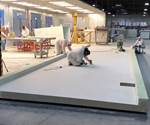FRP pultrusions replace wood for structural applications
Unlike wood, fiber-reinforced polymer (FRP) is unaffected by salt spray, moisture or prolonged immersion in water, making it a good material choice for structural applications in harsh environments.
Wood is revered for a reason — it is used for creating warm, inviting home environments, furniture, art and more. Remember the wooden rollercoasters of old? Despite its sentimental value, wood can’t make it in most harsh industrial environments, says Eric Kidd at Bedford Reinforced Plastics (Bedford, Pa., U.S.): “When exposed to moisture or water, wood is susceptible to warping, rot, mold and mildew. And when in a seaside or coastal location, the moisture, in addition to higher winds and salt spray, creates an especially corrosive environment that can cause a wood structure to break down more quickly over time.” Unlike wood, fiber-reinforced polymer (FRP) is unaffected by salt spray, moisture or prolonged immersion in water, making it a good material choice for piers, pilings, pedestrian bridges, cooling towers and other structural applications in harsh environments.
Insects, including termites, marine borers and carpenter ants, also pose a threat to wood structures. They eat away at the wood, affecting the integrity of the structure. To fight pests, wooden structures are often treated with hazardous preservatives or coatings, which are environmentally harmful. In contrast, FRP does not require any coatings or preservatives to withstand the effects of corrosion, rot or insects, and it has little environmental impact. And, dimensional stability in extreme weather conditions along with flexural strength make a strong case for FRP’s application in geographic areas that experience harsh temperature extremes.
Kidd describes a project where Bedford’s pultruded FRP materials have replaced wood for a structural application. At the Barrick Goldstrike Mines in northeastern Nevada, environmental regulations dictate that 140°F groundwater pumped from the mine must be cooled (below 80°F) before being released into the adjacent waterway. The tower design needed to allow for substantial seasonal temperature variances as well as extreme weather events.
Contractor Hamon Cooling Towers (Somerville, N.J., U.S.) selected FRP as an alternative to wood and concrete, picking the material for its high strength, light weight and dimensional stability. Hamon chose Bedford’s PROForms pultruded structural shapes based on Bedford’s previous experience with cooling tower structures, and its ability to deliver the product within a tight schedule. In all, Bedford shipped 29 flatbed trucks loaded with PROForms elements, including square tubes, angles, channels and deck board. The composite materials were manufactured with a fire-retardant resin and surfacing veil for UV protection. Today, the cooling tower reportedly continues to deliver excellent performance at the site with minimal required maintenance.
Related Content
-
Refurbishing bridges at half the time, cost versus replacement
Instead of demolishing and rebuilding bridges, SUREbridge doubles the strength and durability of existing structures with an FRP deck for a smart, sustainable solution.
-
Composites end markets: Infrastructure and construction (2024)
Composites are increasingly used in applications like building facades, bridges, utility poles, wastewater treatment pipes, repair solutions and more.
-
CirculinQ: Glass fiber, recycled plastic turn paving into climate solutions
Durable, modular paving system from recycled composite filters, collects, infiltrates stormwater to reduce flooding and recharge local aquifers.


.jpg;width=700;quality=80)
.jpg;width=860)











